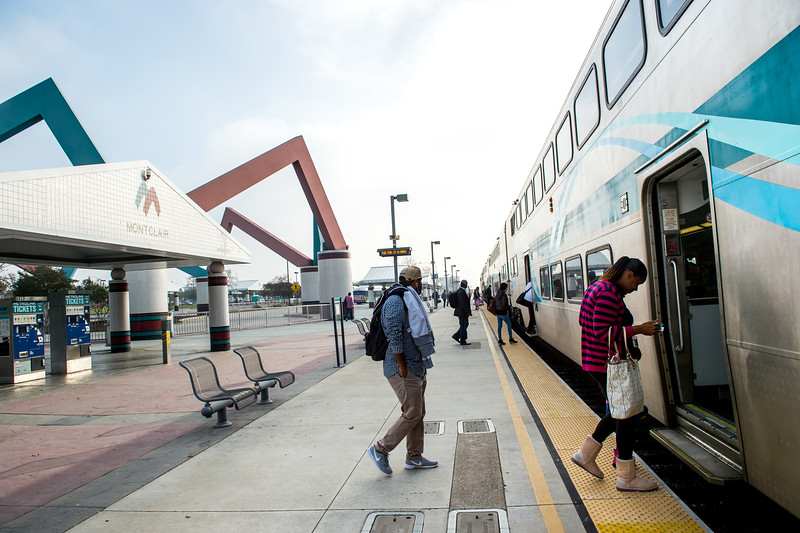The following article appeared in the San Gabriel Valley Tribune on February 17, 2015.
Gold Line authority makes push for next extension from Azusa to Montclair – San Gabriel Valley Tribune

Commuters getting on a Metrolink train heading to Los Angeles at Montclair TransCenter in Montclair on Tuesday, Feb. 17, 2015. Metro Gold Line Foothill Extension Construction Authority is planing the second phase of the light-rail extension project, which will connect Azusa to Montclair. (Photo by Watchara Phomicinda/ San Gabriel Valley Tribune)
By Steve Scauzillo
February 17, 2015
The Metro Gold Line Foothill Extension Construction Authority has asked for a transfer of $33 million in sales-tax funds to jump-start plans and prepare bids for its next project, a 12.3-mile extension from Azusa to Montclair.
As part of the push, the Authority will hold a series of open-house meetings this spring for residents in the six cities that lie within the path: Glendora, San Dimas, La Verne, Pomona, Claremont and Montclair.
Both moves may be in anticipation of key votes coming from the San Gabriel Valley Council of Governments in the next few weeks on which projects to fund.
A transportation matrix was requested by the Los Angeles County Metropolitan Transportation Authority from regional agencies throughout the county, so Metro can prioritize projects for funding. Money could come from a future sales tax slated for the November 2016 ballot which would resemble Measure R, a half-cent tax passed by voters in 2008 for rail and roadway projects.
The Azusa-to-Montclair light-rail segment builds on the 11.5-mile extension from East Pasadena to the Azusa/Glendora border, which will be completed and turned over to Metro in September. Passengers are expected to ride early next year.
The construction group will have $33 million left over, prompting a request to transfer the funding to the next extension, said Lisa Levy Buch, a spokesperson for the construction authority. Metro has not yet made a decision, she said. It has $36 million from Metro that it’s using to perform engineering work, she said.
Doug Tessitor, a member of the Construction Authority board, said the Azusa-to-Montclair project has a completed Environmental Impact Report and a jump on station designs. He said the Authority could begin construction in 2017 and, if fully funded, be completed by 2023.
The $1.18-billion Azusa-to-Montclair extension is not funded ($55 million would come from San Bernardino County), a fact that frustrates Tessitor.
In his view, the dire traffic challenges that keep Southern Californians stuck on freeways for hours each day call for the funding of alternatives, such as light-rail, as soon as possible. In short, the projects ready to build should be funded first.
“I would say there is no question our project (Azusa-to-Montclair Gold Line) should be a priority. But this is a political game,” he said.
Others may not see it that way. Members of the SGVCOG’s Transportation Committee will meet at 4 p.m. Thursday to prioritize local projects. Besides the latest Foothill extension, the committee will consider promoting an east-side extension of the Gold Line from Atlantic Station in East Los Angeles.
Last December, Metro’s board voted to look at building two east-side light-rail extensions, one along the 60 Freeway to South El Monte and another along Washington Boulevard to Whittier. The building of both routes may cost about $5 billion and will take at least two more years to study, Metro reported. That project would not be built until 2035, said Laura Cornejo, project manager.
By forcing the committee to rate projects for funding, Metro would be pitting the south side of the San Gabriel Valley against the north side. In addition, the 1.8 million people in the San Gabriel Valley must compete with projects on the west side of Los Angeles for funding, including the extension of the Purple Line subway beneath Wilshire Boulevard connecting to Beverly Hills, Century City and Westwood at a cost of
$2.8 billion just for the first phase to La Cienega.
The Gold Line from L.A.’s Union Station to Pasadena, and the almost-completed Pasadena-to-Azusa extension have been the result of long-fought battles, Tessitor said. Yet he and others don’t want to see more fighting. He said the Los Angeles subway projects are worthy of funding, as are the eastern rail lines.
A Gold Line extension to Montclair would be the first light-rail line from Los Angeles into San Bernardino County. The extension would serve 17,800 passengers a day, a conservative estimate taken from the EIR. Ridership on the L.A.-to-Pasadena portion has reached a high of about 41,000 boardings a day.
Ridership on Metro trains increased 6 percent from 2012 to 2013. Metro trains gained 9 million trips in 2013 to equal 478 million, the American Public Transportation Association told The Associated Press.
The group said a shift from cars to trains and buses is a growing trend in L.A. and many U.S. cities.
Getting 20,000 or more cars off the traffic-jammed 210 Freeway each day would make a tremendous difference in vehicle speeds, Tessitor said.
“We can put shovel in the dirt in 2017. We are ready,” he said.
